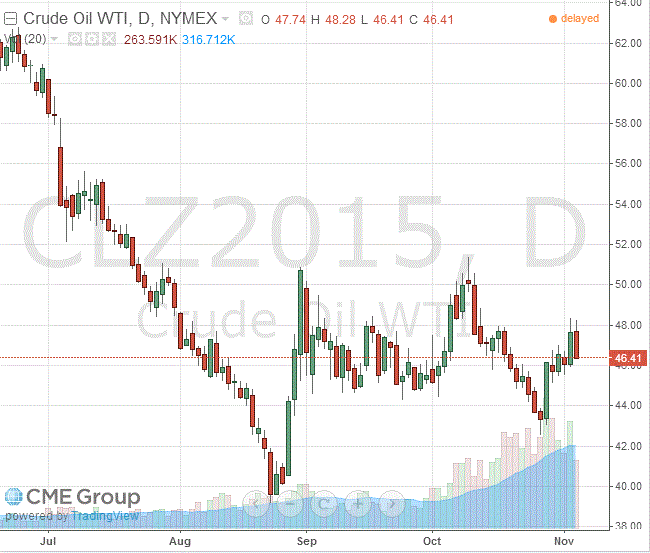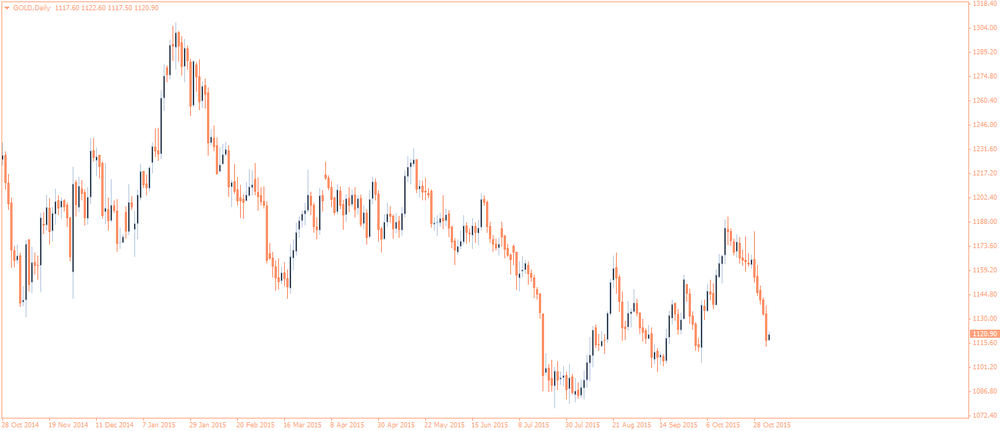Noticias del mercado
-
17:45
Oil prices decline more than 2.5% on U.S. crude oil inventories data
Oil prices dropped on U.S. crude oil inventories data. The U.S. Energy Information Administration (EIA) released its crude oil inventories data on Wednesday. U.S. crude inventories increased by 2.85 million barrels to 482.8 million in the week to October 30. It was the sixth consecutive increase.
Analysts had expected U.S. crude oil inventories to rise by 2.8 million barrels.
Gasoline inventories decreased by 3.3 million barrels, according to the EIA.
Crude stocks at the Cushing, Oklahoma, fell by 0.2 million barrels.
U.S. crude oil imports dropped by 89,000 barrels per day.
Refineries in the U.S. were running at 88.7% of capacity, up from 87.6% the previous week.
Oil prices yesterday rose sharply on concerns over oil supply from Libya and Brazil. Oil workers on Sunday began a strike at state-owned oil producer Petroleo Brasileiro. Libya's oil company National Oil Corp. declared force majeure and suspended deliveries from the port of Zueitina.
WTI crude oil for December delivery declined to $46.41 a barrel on the New York Mercantile Exchange.
Brent crude oil for December fell to $48.84 a barrel on ICE Futures Europe.
-
17:28
Gold price fall on a stronger U.S. dollar
Gold price fell on a stronger U.S. dollar. The U.S. dollar rose against other currencies on comments by the Fed Chairwoman Janet Yellen. She said that the interest rate hike this year is still possible, adding that the decision has not been made yet. Yellen pointed out that the Fed's decision will be depend on the incoming economic data. The Fed chairwoman noted that the U.S. economy is performing well.
Market participants eyed the U.S. economic data. Private sector in the U.S. added 182,000 jobs in October, according the ADP report on Wednesday. September's figure was revised down to 190,000 jobs from a previous reading of 200,000 jobs. Analysts expected the private sector to add 180,000 jobs.
The Institute for Supply Management released its non-manufacturing purchasing managers' index for the U.S. on Wednesday. The index climbed to 59.1 in October from 56.9 in September, beating expectations for a decrease to 56.5.
Market participants are awaiting the release of the U.S. labour market data on Friday. The U.S. unemployment rate is expected to remain unchanged at 5.1% in October. The U.S. economy is expected to add 180,000 jobs in October, after adding 142,000 jobs in September.
December futures for gold on the COMEX today declined to 1113.50 dollars per ounce.
-
17:24
Fed Chairwoman Janet Yelllen: the interest rate hike this year is still possible
The Fed Chairwoman Janet Yelllen testified before the House Financial Services Committee on Wednesday. She said that the interest rate hike this year is still possible, adding that the decision has not been made yet. Yellen pointed out that the Fed's decision will be depend on the incoming economic data.
The Fed chairwoman noted that the U.S. economy is performing well.
"Domestic spending has been growing at a solid pace," she said.
Yellen said the U.S. inflation is still well below the Fed's 2% target due to the low energy prices.
-
16:55
U.S. crude inventories climb by 2.85 million barrels to 482.8 million in the week to October 30
The U.S. Energy Information Administration (EIA) released its crude oil inventories data on Wednesday. U.S. crude inventories increased by 2.85 million barrels to 482.8 million in the week to October 30. It was the sixth consecutive increase.
Analysts had expected U.S. crude oil inventories to rise by 2.8 million barrels.
Gasoline inventories decreased by 3.3 million barrels, according to the EIA.
Crude stocks at the Cushing, Oklahoma, fell by 0.2 million barrels.
U.S. crude oil imports dropped by 89,000 barrels per day.
Refineries in the U.S. were running at 88.7% of capacity, up from 87.6% the previous week.
-
16:12
ISM non-manufacturing purchasing managers’ index climbs to 59.1 in October
The Institute for Supply Management released its non-manufacturing purchasing managers' index for the U.S. on Wednesday. The index climbed to 59.1 in October from 56.9 in September, beating expectations for a decrease to 56.5.
A reading above 50 indicates a growth in the service sector.
The increase was mainly driven by a rise in new orders sub-index. The ISM's new orders index increased to 62.0 in October from 56.7 in September.
The business activity/production index rose to 63.0 in October from 60.2 in September.
The ISM's employment index was up to 59.2 in October from 58.3 in September.
The prices index climbed to 49.1 in October from 48.4 in September.
-
14:33
ADP Employment Report: private sector adds 182,000 jobs in October
Private sector in the U.S. added 182,000 jobs in October, according the ADP report on Wednesday. September's figure was revised down to 190,000 jobs from a previous reading of 200,000 jobs.
Analysts expected the private sector to add 180,000 jobs.
Services sector added 158,000 jobs in October, while goods-producing sector added 24,000 jobs.
The manufacturing sector lost 2,000 jobs in October. It was second consecutive monthly loss.
"Job growth as measured by the ADP Research Institute is not slowing meaningfully in contrast with the recent slowdown in the government's data. The economy is creating close to 200,000 jobs per month," the Chief Economist of Moody's Analytics Mark Zandi said.
Official labour market data will be released on Friday. Analysts expect that U.S. unemployment rate is expected to remain unchanged at 5.1% in October. The U.S. economy is expected to add 180,000 jobs in October, after adding 142,000 jobs in September.
-
10:53
Chinese Markit/Caixin services PMI climbs to 52.0 in October
The Caixin/Markit Services Purchasing Managers' Index (PMI) for China climbed to 52.0 in October from 50.5 in September, exceeding expectations for an increase to 50.8.
The index was driven by a further increase in total new business.
"The Caixin China Services PMI is 52.0 for October, up significantly from 50.5 the previous month. The Caixin Composite Output Index reached 49.9, also much higher than 48.0 in September, close to the neutral 50-point level. This shows that previous stimulus policies have begun to take effect, while the economic structure steadily improved," Dr. He Fan, Chief Economist at Caixin Insight Group, said.
"The economy has started to show signs of stabilizing, reducing the need for a further stimulus. The government must be resolute and push forward the reform agenda in a well-rounded manner to release the long-term potential for sustainable economic growth," he added.
-
07:54
Oil prices flat
West Texas Intermediate futures for December delivery are currently at $47.88 (-0.04%), while Brent crude is at $50.50 (-0.08%). On Tuesday industry group the American Petroleum Institute said U.S. crude inventories rose by 2.8 million barrels in the week ending October 30. The Energy Information Administration will publish its official data later today. A buildup in crude stocks suggests softer demand and weighs on prices.
Meanwhile Bloomberg reported that Libya's Petroleum Facilities Guard halted crude shipments from Zueitina port because of the conflict between the nation's rival governments.
-
07:51
Gold slightly recovered but stayed low
Gold slightly rebounded to $1,120.50 (+0.57%), but stayed under pressure amid speculation that the Federal Reserve could raise rates in December. Outflows from exchange-traded funds and gains in stock markets also weighed on the precious metal. Meanwhile weaker-than-expected reports on the U.S. economy failed to support gold.
Market participants are waiting for more data to assess strength of the U.S. economy and the probability of a data-dependant rate hike. That's why investors will focus on U.S. key jobs report due Friday.
-
00:32
Commodities. Daily history for Nov 3’2015:
(raw materials / closing price /% change)
Oil 47.66 -0.50%
Gold 1,117.10 +0.27%
-

